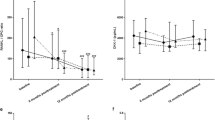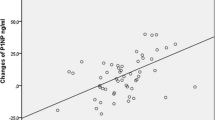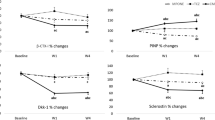Abstract
The effects of soluble TNF-α receptor, etanercept, on bone metabolism were investigated in patients with rheumatoid arthritis (RA). Thirty RA patients were administered etanercept once or twice a week for more than 6 months. We evaluated clinical and laboratory parameters and measured urinary excretion levels of pyridinoline (PYD), deoxypyridinoline (DPD), cross-linked N-telopeptides of type I collagen (NTX), and serum levels of bone alkaline phosphatase (BAP), osteoprotegerin (OPG), and soluble receptor activator of NFκB ligand (sRANKL) at the baseline and at 3 and 6 months after initial treatment with etanercept. Etanercept treatment resulted in an improvement of symptoms due to RA and in a reduction of urinary excretion levels of PYD and DPD as well as serum sRANKL levels, with a significant difference at 6 months, and an increase of serum BAP levels at 3 and 6 months after the initial treatment with etanercept. Urinary NTX and serum OPG levels did not show a significant change at 3 and 6 months after the initial treatment, but serum OPG levels did show a reverse correlation with serum CRP levels, suggesting that the regulation of inflammation in RA may result in an induction of OPG production. Etanercept may have the ability to reduce the levels of bone resorption markers and to increase the levels of a bone formation marker while reducing sRANKL formation in RA patients.
Similar content being viewed by others
References
Sambrook PN (2002) The skeleton in rheumatoid arthritis; common mechanisms for bone erosion and osteoporosis? J Rheumatol 27:2541–2542
Haugeberg G, Uhlig T, Falch JA, Halse JI, Kvien TK (2000) Bone mineral density and frequency of osteoporosis in female patients with rheumatoid arthritis: results from 394 patients in the Oslo County Rheumatoid Arthritis Register. Arthritis Rheum 43:522–530
Kroger H, Honkanen R, Saarikoski S, Alhava E (1994) Decreased axial bone mineral density in perimenopausal women with rheumatoid arthritis—a population based study. Ann Rheum Dis 53:18–23
Lane NE, Pressman AR, Star VL, Cummings SR, Nevitt MC (1995) Rheumatoid arthritis and bone mineral density in elderly women. J Bone Miner Res 10:257–263
Buckley LM, Leib ES, Cartularo KS, Vacek PM, Cooper SM (1995) Effects of low dose corticosteroids on the bone mineral density of patients with rheumatoid arthritis. J Rheumatol 22:1055–1059
Butler RC, Davie MW, Worsfold M, Sharp CA (1991) Bone mineral content in patients with rheumatoid arthritis: relationship to low-dose steroid therapy. Br J Rheumatol 30:86–90
Martin JC, Munro R, Campbell MK, Reid DM (1997) Effects of disease and corticosteroids in appendicular bone mass in postmenopausal women with rheumatoid arthritis comparison with axial measurements. Br J Rheumatol 36:43–49
Celiker R, Gokce-Kutsal Y, Cindas A, Ariyurek M, Renda N, Koray Z, Basgoze O (1995) Osteoporosis in rheumatoid arthritis effect of disease activity. Clin Rheumatol 14:429–433
Laan RF, van Riel PL, van de Putte LB (1992) Bone mass in patients with rheumatoid arthritis. Ann Rheum Dis 51:826–832
Kallia AA, Meyels OL, Laubscher R (1995) Prevalence of metacarpal ostopenia in young rheumatoid arthritis patients. Clin Rheumatol 14:617–625
Arend WP, Dayer J-M (1995) Inhibition of the production and effects of interleukin-1 and tumor necrosis factor alpha in rheumatoid arthritis. Arthritis Rheum 38:151–160
Maini RN, Taylor PC (2000) Anti-cytokine therapy for rheumatoid arthritis. Annu Rev Med 51:207–229
Taylor PC (2003) Anti-TNF alpha therapy for rheumatoid arthritis: an update. Intern Med 432:15–20
Kageyama Y, Takahashi M, Torikai E, Suzuki M, Ichikawa T, Nagafusa T, Koide Y, Nagano A (2007) Treatment with anti-TNF-alpha antibody infliximab reduces serum IL-15 levels in patients with rheumatoid arthritis. Clin Rheumatol 26:505–509
Torikai E, Kageyama Y, Takahashi M, Suzuki M, Ichikawa T, Nagafusa T, Nagano A (2006) The effect of infliximab on bone metabolism markers in patients with rheumatoid arthritis. Rheumatology (Oxford) 45:761–764
Spector TD, James IT, Hall GM, Thompson PW, Perrett D, Hart DJ (1993) Increased levels of urinary collagen crosslinks in females with rheumatoid arthritis. Clin Rheumatol 12:240–244
Black D, Marabani M, Sturrock RD, Robins SP (1989) Urinary excretion of the hydroxypyridinium cross links of collagen in patients with rheumatoid arthritis. Ann Rheum Dis 48:641–644
Seibel MJ, Duncan A, Robins SP (1989) Urinary hydroxy-pyridinium crosslinks provide indices of cartilage and bone involvement in arthritic diseases. J Rheumatol 16:964–970
Gravallese EM (2002) Bone destruction in arthritis. Ann Rheum Dis 61(Suppl 2):ii84–ii86
Lum L, Wong BR, Josien R, Becherer JD, Erdjument-Bromage H, Schlöndorff J, Tempst P, Choi Y, Blobel CP (1999) Evidence for a role of a tumor necrosis factor-alpha (TNF-alpha)-converting enzyme-like protease in shedding of TRANCE, a TNF family member involved in osteoclastogenesis and dendritic cell survival. J Biol Chem 274:13613–13618
Kong YY, Yoshida H, Sarosi I, Tan HL, Timms E, Capparelli C, Morony S, Oliveira-dos-Santos AJ, Van G, Itie A, Khoo W, Wakeham A, Dunstan CR, Lacey DL, Mak TW, Boyle WJ, Penninger JM (1999) OPGL is a key regulator of osteoclastogenesis, lymphocyte development and lymph-node organogenesis. Nature 397:315–323
Miyamoto N, Higuchi Y, Mori K, Ito M, Tsurudome M, Nishio M, Yamada H, Sudo A, Kato K, Uchida A, Ito Y (2002) Human osteosarcoma-derived cell lines produce soluble factor(s) that induces differentiation of blood monocytes to osteoclast-like cells. Int Immunopharmacol 2:25–38
Lam J, Nelson CA, Ross FP, Teitelbaum SL, Fremont DH (2001) Crystal structure of the TRANCE/RANKL cytokine reveals determinants of receptor-ligand specificity. J Clin Invest 108:971–979
Nagai M, Kyakumoto S, Sato N (2000) Cancer cells responsible for humoral hypercalcemia express mRNA encoding a secreted form of ODF/TRANCE that induces osteoclast formation. Biochem Biophys Res Commun 269:532–536
Yasuda H, Shima N, Nakagawa N, Yamaguchi K, Kinosaki M, Mochizuki S, Tomoyasu A, Yano K, Goto M, Murakami A, Tsuda E, Morinaga T, Higashio K, Udagawa N, Takahashi N, Suda T (1998) Osteoclast differentiation factor is a ligand for osteoprotegerin/osteoclastogenesis-inhibitory factor and is identical to TRANCE/RANKL. Proc Natl Acad Sci USA 95:3597–3602
Aubin JE, Bonnelye E (2000) Osteoprotegerin and its ligand: a new paradigm for regulation of osteoclastogenesis and bone resorption. Osteoporosis Int 11:905–913
Simonet WS, Lacey DL, Dunstan CR, Kelley M, Chang MS, Lüthy R, Nguyen HQ, Wooden S, Bennett L, Boone T, Shimamoto G, DeRose M, Elliott R, Colombero A, Tan HL, Trail G, Sullivan J, Davy E, Bucay N, Renshaw-Gegg L, Hughes TM, Hill D, Pattison W, Campbell P, Sander S, Van G, Tarpley J, Derby P, Lee R, Boyle WJ (1997) Osteoprotegerin: a novel secreted protein involved in the regulation of bone density. Cell 89:309–319
Fazzalari NL, Kuliwaba JS, Atkins GJ, Forwood MR, Findlay DM (2001) The ratio of messenger RNA levels of receptor activator of nuclear factor kappaB ligand to osteoprotegerin correlates with bone remodeling indices in normal human cancellous bone but not in osteoarthritis. J Bone Miner Res 16:1015–1027
Min H, Morony S, Sarosi I, Dunstan CR, Capparelli C, Scully S, Van G, Kaufman S, Kostenuik PJ, Lacey DL, Boyle WJ, Simonet WS (2000) Osteoprotegerin reverses osteoporosis by inhibiting endosteal osteoclasts and prevents vascular calcification by blocking a process resembling osteoclastogenesis. J Exp Med 192:463–474
Gori F, Hofbauer LC, Dunstan CR, Spelsberg TC, Khosla S, Riggs BL (2000) The expression of osteoprotegerin and RANK ligand and the support of osteoclast formation by stromal-osteoblast lineage cells is developmentally regulated. Endocrinology 141:4768–4776
Ziolkowska M, Kurowska M, Radzikowska A, Luszczykiewicz G, Wiland P, Dziewczopolski W, Filipowicz-Sosnowska A, Pazdur J, Szechinski J, Kowalczewski J, Rell-Bakalarska M, Maslinski W (2002) High levels of osteoprotegerin and soluble receptor activator of nuclear factor kappa B ligand in serum of rheumatoid arthritis patients and their normalization after anti-tumor necrosis factor alpha treatment. Arthritis Rheum 46:1744–1753
Takahashi M, Hoshino H, Kushida K, Inoue T (1995) Direct measurement of crosslinks, pyridinoline, deoxypyridinoline, and pentosidine, in the hydrolysate of tissues using high-performance liquid chromatography. Anal Biochem 232:158–162
Okamoto H, Yamamura M, Morita Y, Harada S, Makino H, Ota Z (1997) The synovial expression and serum levels of interleukin-6, interleukin-11, leukemia inhibitory factor, and oncostatin M in rheumatoid arthritis. Arthritis Rheum 40:1096–1105
Seriolo B, Paolino S, Sulli A, Cutolo M (2006) Are there any positive effects of TNF-alpha blockers on bone metabolism? Reumatismo 58:199–205
Seriolo B, Paolino S, Sulli A, Ferretti V, Cutolo M (2006) Bone metabolism changes during anti-TNF-alpha therapy in patients with active rheumatoid arthritis. Ann N Y Acad Sci 1069:420–427
Ostanek L, Pawlik A, Brzosko I, Brzosko M, Sterna R, Drodzik M, Gawroska-Szklarz B (2004) The urinary excretion of pyridinoline and deoxypyridinoline during rheumatoid arthritis therapy with infliximab. Clin Rheumatol 23:214–217
Eyre DR, Koob TJ, Van Ness KP (1984) Quantitation of hydroxypyridinium crosslinks in collagen by high-performance liquid chromatography. Anal Biochem 137:380–388
Greenspan S, Rosen HN, Parker RA (1998) Early changes in biochemical markers of bone turnover predict the long-term response to alendronate therapy in representative elderly women: a randomized clinical trial. J Bone Miner Res 13:1431–1438
Ravn P, Clemmesen B, Christiansen C (1999) Biochemical markers can predict the response in bone mass during alendronate treatment in early postmenopausal women. Bone 24:237–244
Gorai I, Taguchi Y, Chaki O, Nakayama M, Minaguchi H (1997) Specific changes of urinary excretion of cross-linked N-telopeptides of type I collagen in pre- and postmenopausal women: correlation with other markers of bone turnover. Calcif Tissue Int 60:317–322
Iwamoto J, Takeda T, Ichimura S (2003) Urinary cross-linked N-telopeptides of type I collagen levels in patients with rheumatoid arthritis. Calcif Tissue Int 72:491–497
Takahashi M, Kushida K, Hoshino H, Suzuki M, Sano M, Miyamoto S, Inoue T (1996) Concentrations of pyridinoline and deoxypyridinoline in joint tissues from patients with osteoarthritis or rheumatoid arthritis. Ann Rheum Dis 55:324–327
Simonet WS, Lacey DL, Dunstan CR, Kelley M, Chang MS, Lüthy R, Nguyen HQ, Wooden S, Bennett L, Boone T, Shimamoto G, DeRose M, Elliott R, Colombero A, Tan HL, Trail G, Sullivan J, Davy E, Bucay N, Renshaw-Gegg L, Hughes TM, Hill D, Pattison W, Campbell P, Sander S, Van G, Tarpley J, Derby P, Lee R, Boyle WJ (1997) Osteoprotegerin: a novel secreted protein involved in the regulation of bone density. Cell 89:309–319
Kwon BS, Wang S, Udagawa N, Haridas V, Lee ZH, Kim KK, Oh KO, Greene J, Li Y, Su J, Gentz R, Aggarwal BB, Ni J (1998) TR1, a new member of the tumor necrosis factor receptor superfamily, induces fibroblast proliferation and inhibits osteoclastogenesis and bone resorption. FASEB J 12:845–854
Gravallese EM, Goldring SR (2000) Cellular mechanisms and the role of cytokines in bone erosions in rheumatoid arthritis. Arthritis Rheum 43:2143–2151
Terpos E, Szydlo R, Apperley JF, Hatjiharissi E, Politou M, Meletis J, Viniou N, Yataganas X, Goldman JM, Rahemtulla A (2003) Soluble receptor activator of nuclear factor kappaB ligand-osteoprotegerin ratio predicts survival in multiple myeloma: proposal for a novel prognostic index. Blood 102:1064–1069
Geusens PP, Landewé RB, Garnero P, Chen D, Dunstan CR, Lems WF, Stinissen P, van der Heijde DM, van der Linden S, Boers M (2006) The ratio of circulating osteoprotegerin to RANKL in early rheumatoid arthritis predicts later joint destruction. Arthritis Rheum 54:1772–1777
Min H, Morony S, Sarosi I, Dunstan CR, Capparelli C, Scully S, Van G, Kaufman S, Kostenuik PJ, Lacey DL, Boyle WJ, Simonet WS (2000) Osteoprotegerin reverses osteoporosis by inhibiting endosteal osteoclasts and prevents vascular calcification by blocking a process resembling osteoclastogenesis. J Exp Med 192:463–474
Gori F, Hofbauer LC, Dunstan CR, Spelsberg TC, Khosla S, Riggs BL (2000) The expression of osteoprotegerin and RANK ligand and the support of osteoclast formation by stromal-osteoblast lineage cells is developmentally regulated. Endocrinology 141:4768–4776
Hofbauer LC, Heufelder AE (2001) The role of osteoprotegerin and receptor activator of nuclear factor kappaB ligand in the pathogenesis and treatment of rheumatoid arthritis. Arthritis Rheum 44:253–259
Tak PP, Bresnihan B (2000) The pathogenesis and prevention of joint damage in rheumatoid arthritis: advances from synovial biopsy and tissue analysis. Arthritis Rheum 43:2619–2633
Romans E, Gillespie MT, Martin TJ (2002) Involvement of receptor activator of NF kappaB ligand and tumor necrosis factor-alpha in bone destruction in rheumatoid arthritis. Bone 30:340–346
Fazzalari NL, Kuliwaba JS, Atkins GJ, Forwood MR, Findlay DM (2001) The ratio of messenger RNA levels of receptor activator of nuclear factor kappaB ligand to osteoprotegerin correlates with bone remodeling indices in normal human cancellous bone but not in osteoarthritis. J Bone Miner Res 16:1015–1027
Kotake S, Udagawa N, Takahashi N (1998) Presence of osteoclastogenesis inhibitory factor osteoprotegerin in synovial fluids from patients with rheumatoid arthritis. Arthritis Rheum 41(Suppl):S320
Kotake S, Udagawa N, Hakoda M, Mogi M, Yano K, Tsuda E, Takahashi K, Furuya T, Ishiyama S, Kim KJ, Saito S, Nishikawa T, Takahashi N, Togari A, Tomatsu T, Suda T, Kamatani N (2001) Activated human T cells directly induce osteoclastogenesis from human monocytes. Arthritis Rheum 44:1003–1012
Hofbauer LC, Lacey DL, Dunstan CR, Spelsberg TC, Riggs BL, Khosla S (1999) Interleukin-1beta and tumor necrosis factor-alpha, but not interleukin-6, stimulate osteoprotegerin ligand gene expression in human osteoblastic cells. Bone 25:255–259
Rossa C, Ehmann K, Liu M, Patil C, Kirkwood KL (2006) MKK3/6-p38 MAPK signaling is required for IL-1beta and TNF-alpha-induced RANKL expression in bone marrow stromal cells. J Interferon Cytokine Res 26:719–729
Dai SM, Nishioka K, Yudoh K (2004) Interleukin (IL) 18 stimulates osteoclast formation through synovial T cells in rheumatoid arthritis: comparison with IL1 beta and tumor necrosis factor alpha. Ann Rheum Dis 63:1379–1386
Schoppet M, Henser S, Ruppert V, Stubig T, Al-Fakhri N, Maisch B, Hofbauer LC (2007) Osteoprotegerin expression in dendritic cells increases with maturation and is NF-kappaB-dependent. J Cell Biochem 100:1430–1439
Author information
Authors and Affiliations
Corresponding author
Rights and permissions
About this article
Cite this article
Yasunori, K., Masaaki, T., Tetsuyuki, N. et al. Reduction of urinary levels of pyridinoline and deoxypyridinoline and serum levels of soluble receptor activator of NF-kappaB ligand by etanercept in patients with rheumatoid arthritis. Clin Rheumatol 27, 1093–1101 (2008). https://doi.org/10.1007/s10067-008-0870-8
Received:
Revised:
Accepted:
Published:
Issue Date:
DOI: https://doi.org/10.1007/s10067-008-0870-8




